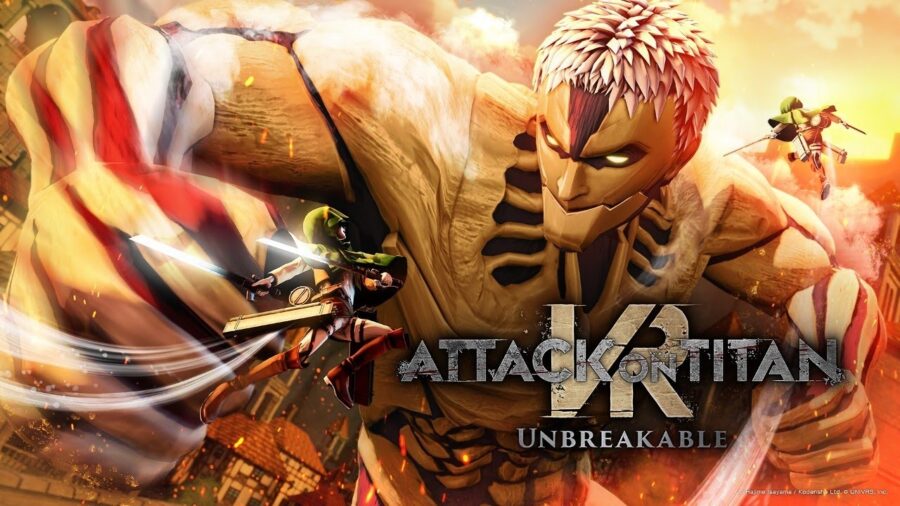
TL;DR for Attack on Titan VR: Unbreakable
(played on a Meta Quest 3 128 GB model)
| Pros | Cons |
| + Flow-inducing core gameplay | – Exclusively snap-to-turn |
| + Solid VA and sound design | – Disappointing textures |
| + Deeply replayable | |
| + Well polished for early access |
Performance art is pretentious.
Reality TV is exploitative and fake.
Country music is the vapid propaganda of working-class pacification.
These kinds of broad, sweeping generalizations are wrong…
Mostly.
Big claims about entire genres of art can at best only be hyperbole—exaggerations for effect—but they often grow from a kernel of truth.
Another such bit of truth-kernelled hyperbole?
Anime is only as good as its action scenes.
I said it. I said it and I (more or less) meant it!
From the teleporting super saiyan battles of Dragon Ball Z to the camera-warping acceleration of Redline, anime is at its best when it’s serving up adrenaline, and Attack on Titan is no exception.
Attack on Titan (AoT for short) is one of many anime series I’ve found to be impenetrably hard to watch all the way through.
My viewing experiences always go something like this:
I buy the hype and start an anime. The premise is cool. The animation is good.
And then the vast and inevitable ocean—wave after wave—of heavy-handed exposition and nuance-free dialogue comes crashing forth, letting the viewer up for air far too occasionally with killer sequences of throttle-cranking action.
I last maybe a season before the eighteen minutes an episode of echoey internal monologues played over mostly static face pans drive me off into YouTube’s open arms where I binge through a plot summary and all the series’ action sequences.
A small glowing gem floats out of my browser and absorbs into my crown chakra.
I am sated.
My thinning chrysalis is restored in a burst of soft light and I sleep for another hundred years.
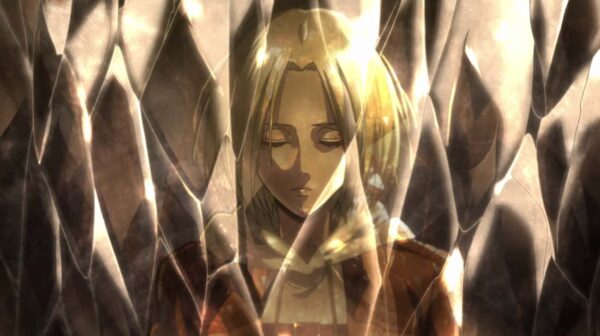
(Image credit: Ranker)
My point is that when it comes to anime, the action is almost exclusively the good stuff.
And thankfully, Attack on Titan VR: Unbreakable keeps it to the good stuff.
If you’re unfamiliar with Attack on Titan, here’s the gist:
Humans live in a world dominated by “Titans”; vaguely humanoid giants of varying size, shape, power, and intelligence with a mysterious origin. Humans build massive walls and special gear to defend themselves from the Titans. The Titans break the walls and you—as a soldier in the “Survey Corps” (also known as the “Scout Regiment”, depending on whether you watched the show with subtitles or dubbed), the titan-fighting branch of the human military—use your special “Omni-Directional Mobility” (ODM) gear to stop them from wiping humanity out.
Your two upgradable swords and ODM gear are what you use to take out Titans. The ODM gear is essentially a gas-powered body suit featuring dual grappling hooks and some minor jetpack-like propulsion capabilities. And it is absolutely sick as hell.
You swing from building to building slashing through Titans with your swords, slicing at their limbs and necks like a samurai Peter Parker.
In this way, Attack on Titan’s aerial acrobatics have the rare privilege of being a genuinely unique power fantasy. No other IP has this particular kind of combat at its heart. Yes, Spiderman and a few other games have a basically similar style of locomotion, but they don’t have the freedom to course correct and double jump that comes with the ODM’s gas propulsion, nor the giant-slaying swordsman panache.
You are a deadly projectile, swinging through colossal opponents with surgical precision. This is the core of the game, and boy, does it ever feel good.
Gameplay is smooth and satisfying, but it has some quirks that take time to get used to.
Two examples:
True to the show, hangtime here lasts longer than in real-life physics.
It might feel strangely floaty at first, but it allows for epic anime flourishes like mid-air blade replacements and on-the-fly trajectory decisions.
Additionally, your sword strikes have a kind of slash-and-then-damage samurai movie logic that feels weird and wrong until it doesn’t. Eventually, you embrace the sheer cinema of having propelled well past your opponent by the time their necks gash open and spray about.
However, the delay of your strikes does still feel clunky on the odd occasion that you want to repeatedly thwack away at a target from a stationary position instead of casting your usual on-the-move isolated slashes.
And while this style of combat is less common, I wouldn’t mention it if it never came up.
Speaking of mechanics, I recommend spending some time in the tutorial just swinging around for a while before actually starting the game. Levels proper are bound to a timer, so the tutorial is the only chance you have to freely practice your fundamentals without the pressure of quickly hitting your objectives.
There are only a few different controls to learn, but stringing them together well makes for fluid and dynamic emergent gameplay. Stumbling upon subtleties of movement that aren’t immediately obvious—and then applying and mastering them—feels absolutely badass.
There’s one extremely handy movement tech that I only realized in the final level of the second chapter (which is to say- the very last level of the current early access release)!
It turns out that if you hook onto one spot with both of your grapples and then hold the left thumbstick to one side as you propel towards it, you’ll also swing around the object you’re hooked onto. And since the only way to kill a Titan is to slash the weak points at the napes of their necks, this could have made all the difference in a lot of my near misses caused by Titans turning towards me mid-swing.
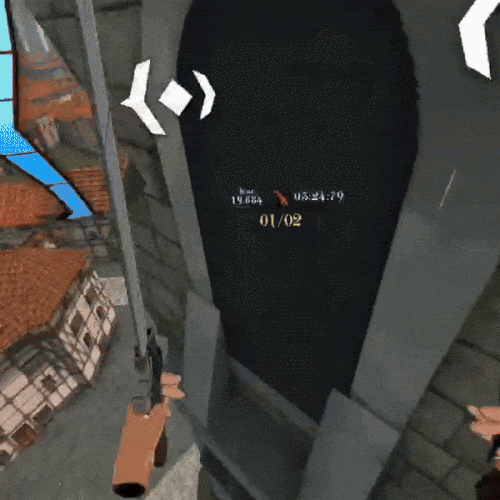
Learning this technique—as well as having unlocked new swords by the end of my three or four hour run—made me want to go back and replay all of the levels on which I got anything less than five stars. The game is already pretty difficult just to get through, but it also rates your performance per level, dangling the possibility of a five-star rating; bewitching you into replaying your way to mastery.
Levels are made up of missions strung together through different parts of the walled city and come in three different types: kill Titans, collect supplies (while avoiding Titans), and defend a structure.
On most levels, I earned three-star scores or higher.
On the structure-defense levels though?
After multiple attempts just to beat them, I never got higher than a one-star rating.
These ones are tough.
Titans swarm your location and you have to try and find the right balance of stopping them in their tracks by cutting off their limbs, killing them outright, or drawing them away from the objective.
These levels pushed me into my most impressive combos, sometimes killing multiple Titans before touching the ground! Yet I still never broke two stars.
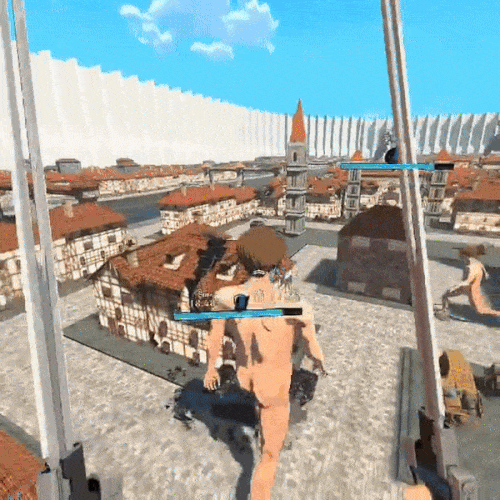
Once you’re out of the tutorial, Attack on Titan does not hold your hand.
This game is a reasonable challenge to complete and a massive challenge to perfect.
If you’re competitive like me, you’ll want to jump back in the mix to beat your high scores.
And if you’re really competitive, there’s a live leaderboard you can try and climb to beat everybody else’s high scores!
Fans of the show will appreciate the appearance of regular characters in the Survey Corps/Scout Regiment as NPC sidekicks, hanging out with you at home base and then swinging into battle with you, occasionally narrating your combat.
For those who don’t know the show, enough narrative is delivered through manga-like animatics at key points of the game to keep a sense of story without devolving into boring lore dumps.
This integration of story elements keeps the game immersive.
Further to that end, Attack on Titan has a lot of diegetic elements that add flair and a distinctly anime charm to the whole affair:
The menus come in the form of an official Survey Corps log which you sign with a pen to confirm selections.
Reloading your weapons is done by dropping broken blades to the ground and then sliding your hilts to the fresh replacement blades at your belt.
And if you’re a real dyed-in-the-wool weeb then good news, instead of using the thumbstick to move along the ground you can opt to throw your arms back into a Naruto run!
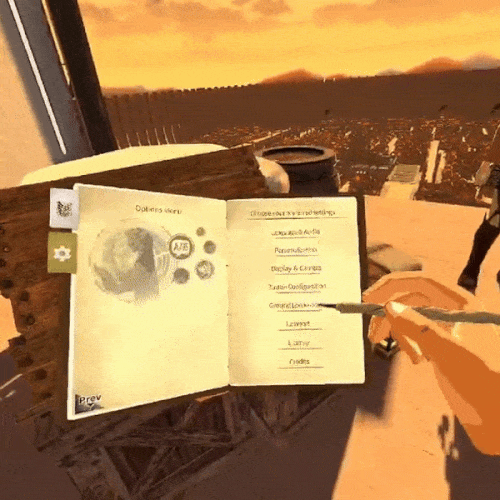
Not only is this the ultimate Japanophile wet dream as well as a fun bit of performance for streamers, but it also helps to keep your hand off the left thumbstick, potentially preventing you from accidentally strafing mid-air in moments where you meant only to subtly guide your aerial trajectory; a mistake I made often.
And if that sounds annoying to you, worry not. Most control schemes can be changed in the settings.
One setting, however, that I found frustratingly absent was smooth turning.
For a game so focused on fluid acrobatic combat, it seems out of place—even a bit jarring—to only be able to snap turn.
Now while I’ve still got my complaining hat on, let’s cover some more critical ground:
Issues with textures showed up during my playthrough on the Meta Quest 3; not only in the far-away textures that succumbed to the game’s mediocre draw distance, but also in very close-up textures revealing a crude smudginess. This—as well as some clipping between character models—becomes especially evident should you get snatched up by a Titan, as your perspective becomes contiguous with their grasp.
Now, as a matter of taste, I was also disappointed with (most of) the Titans’ comparative lack of creepiness.
In the show, all of the Titans don a visage yanked firmly out of the depths of the uncanny valley; sporting soft—sometimes friendly or even child-like—features that betray the monstrous and mindless hunger that pilots their gargantuan, nude bodies.
Here, the soft and kind features remain, but somehow the eeriness is all but gone.
It’s as though that soft kindness was dialed up just one too many notches on most of the Titans’ models such that they just don’t really look threatening.
We just don’t get enough of a glimpse at the monster behind the mask.

(Image credit: Attack on Titan Wiki – Fandom/Auganix)
Bugs, it should be mentioned, were present but few and far between; less than I expected for an early access game and honestly less than even most full-release VR games.
Something about the platform seems almost averse to polish, but—by early access standards at the very least—Attack on Titan does well to curb that trend.
Overall, Attack on Titan VR: Unbreakable is a worthy entry into the space for an IP with big shoes to fill.
The game as it stands is small, but so is the limited-time price tag of only USD $5.
And for the competitive type, even just this early access version offers a lot of replayability should you aim for five-star scores across every level.
Plus, with the promise of a future co-op mode, quality-of-life adjustments, and an extended campaign, the full game seems poised to deliver even better on the lofty promises of high-flying dynamic swordplay made by its TV precursor.
If you want a deep retelling of the eponymous anime then this game is not for you.
But if you want an aerial hotbed of emergent gameplay; an exercise in flow; an immersive experience with strong core mechanics that reward patience and intentionality, a decent challenge range, epic sound design, and a layer of polish not known in most pre-release standalone VR titles, then this game is undeniably worthwhile.
With a low price tag and smoother edges than you’d expect from an early access offering, any action-hungry gamer looking for a cheap thrill owes it to themself to go buy this game immediately.
For now—for its current scope and value—Attack on Titan VR: Unbreakable gets a well-deserved 8/10.
Scoring & Rubric
Scores are out of 10, where 10 is a masterpiece, 1 is unplayable, and 5 is just average.
Gameplay is weighted heavier in the overall score.
Gameplay – 8
Immersion – 7
Visuals – 7
Sound – 8
Performance – 8
Replayability – 9
About the author
Kierkegaard once said that the artist is like one stuck inside Phalaris' brass bull, which burned up its victims and—due to the formation of its apertures—made beautiful music from their anguish.
The critic, he said, is just like the artist except he doesn't have the anguish in his heart nor the music on his lips.
A lifelong gamer based out of Vancouver, Pelé disagrees with Kierkegaard.
